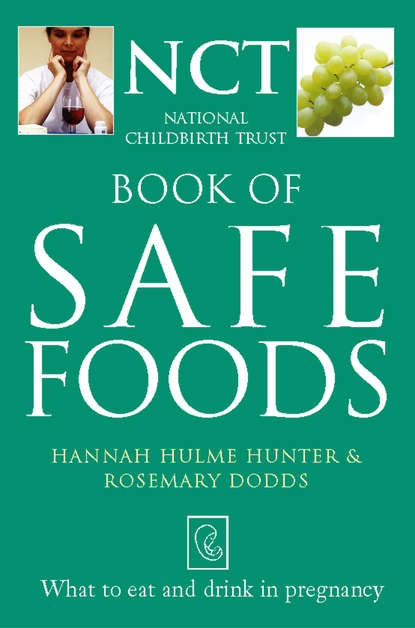По всем вопросам обращайтесь на: info@litportal.ru
(©) 2003-2024.
✖
Safe Food: What to eat and drink in pregnancy
Автор
Год написания книги
2019
Настройки чтения
Размер шрифта
Высота строк
Поля
We cannot eat too much fruit and too many vegetables! We should all aim to eat five servings each day. A serving of fruit and vegetables is equivalent to:
a piece of fruit – one apple, a single banana, a large slice of melon and so on
12 chunks of tinned pineapple
a small glass of unsweetened fruit juice
a large bowl of salad
a large tomato
3 tablespoons of peas
2 tablespoons of carrots or cabbage
a handful of raisins
vegetable curry or vegetable stir-fry (counts as two servings if eaten as a main meal)
What about protein?
Protein foods fit into one of the smaller sections of our plate. This may surprise some people. The traditional approach to English meal planning tended to over-emphasise our need for protein – especially for meat protein. Nutritionists now know that we do not need as much protein as previously thought.
But protein is still a very important part of our diet. We need it to repair and maintain the basic building blocks of our bodies – our cells. We also need it to grow new cells; in particular, we need protein while pregnant to grow our babies. We need protein, too, to grow new blood cells and to produce antibodies (the special cells that help our bodies fight infection). Meat protein, in particular, is rich in valuable minerals such as iron and zinc. We talk more about these nutrients in Chapter 2 (#u75bfaf00-ca22-550b-acdd-4e132b10fe76).
Protein comes from two food sources – animal and vegetable. Whatever the source, the basic component of protein is the amino acid. There are many different amino acids. Our bodies can make some, but most need to be taken in our diet. The balance of amino acids in animal protein (in meat, milk and eggs) is similar to the balance required by our bodies. The balance of amino acids in vegetable protein (in nuts and lentils, for example) varies from food to food. This is why people who do not eat meat or drink milk need to eat a wide range of vegetable protein in order to get a good balance of amino acids.
Pregnancy increases the need for protein – but only by a small amount. A balanced diet including 2–3 servings of protein – vegetable, meat or a mixture of both – will easily take care of the extra bit required during pregnancy.
Animal protein
Animal sources of protein include all kinds of meat and fish. Turkey, chicken and fish tend to contain less saturated fat than red meat. (Saturated fat is the most harmful type of fat.) So, if you eat red meat (such as beef, lamb and pork), try to choose lean cuts – remember, you don’t need much!
Oily fish, such as mackerel, tuna and sardines (fresh or tinned), are particularly recommended as sources of protein – because they also give us essential fatty acids. We explain more about fatty acids later in this chapter.
Vegetable protein
Vegetable sources of protein include:
nuts and seeds
peanut butter (peanuts contain as much protein as most cheeses and twice as much as eggs – but see the note about peanut allergy at the end of Chapter 7 (#litres_trial_promo))
meat substitutes, tofu (made from soya beans) and Quorn (made from a fungus)
pulses including lentils (such as masur dhal), baked beans, kidney beans, black-eyed beans, butter beans, borlotti beans, mung beans, broad beans and all kinds of peas.
A well-planned vegetarian diet is extremely healthy. Vegetable protein foods are rich in fibre as well as protein, and contain many vitamins and minerals. Avoiding meat and using vegetable protein foods can be a good way of reducing your intake of saturated fat, and increasing your intake of fibre.
The protein in vegetable protein foods is less concentrated than the protein in animal protein foods. Servings tend to be larger. If you do not eat meat or drink milk, it is a good idea to include a serving of vegetable protein at each meal. Some other important nutrients are less concentrated in vegetable protein. Choose vegetable protein foods rich in iron, zinc, calcium and vitamin B
(more about all of these nutrients in Chapter 2 (#u75bfaf00-ca22-550b-acdd-4e132b10fe76)).
How much animal protein?
We can get enough protein from just two servings of meat protein foods each day. A serving of animal protein is equivalent to:
2 slices of roast chicken or turkey
half a small mackerel fillet
2 rounded tablespoons of tinned tuna chunks
1 small fillet of white fish such as cod
2 slices of lamb, beef or pork
1 small lamb or pork chop
2 eggs
1 slice of tinned corned beef
How much vegetable protein?
Aim for 2–3 servings of vegetable protein foods each day. A serving of vegetable protein is equivalent to:
1 tablespoon of peanut butter
2 heaped tablespoons of nuts or seeds
3 tablespoonfuls of cooked kidney beans or chick-peas
one-third of a large tin (420g) of baked beans
2–3 tablespoons of thick lentil dhal
a small pot (100g) of hummus (try the low-fat variety)
a large cup of soya milk
one-third of a packet of tofu
What about milk foods?
The second of the small sections on our imaginary plate is for milk-based foods, or dairy products. Milk – and foods made from it, such as cheese, yoghurt and fromage frais – is an excellent and convenient source of calcium, zinc, some B group vitamins and protein.
Milk and milk products contain varying amounts of fat, depending on the type of milk and the way in which it has been processed. ‘Skimmed’ milk has had all the fat removed and ‘semi-skimmed’ milk has had half the fat removed. Both have the same amount of protein as whole milk – and slightly more calcium.





